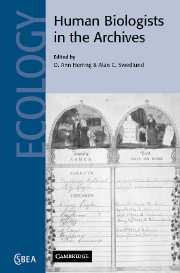 Human Biologists in the Archives
Human Biologists in the Archives Published online by Cambridge University Press: 12 August 2009
Introduction
My aim is to present an overview of the main trends in the development and practice of archival anthropology, reflecting on the paths by which the project has developed, and noting not only the mainstream, but also the occasional intriguing backwater. Before moving on in later sections to a description of data sources, analytical approaches, and exemplary studies, I shall briefly outline the broad range of anthropological studies that utilize archival data, and offer some thoughts on the particular qualities of the sources which lend themselves to anthropological analysis. Finally, I give some hostages to fortune in a brief statement of future directions for this endeavor. Now and then, I shall indicate a little of the parallel work done especially by historians and historical geographers, to remind us of the commonality of interest across academic disciplines, and to show what keeps the biological anthropology distinct.
Archival anthropology is in many ways no different in spirit and intent from the discipline as followed by many workers studying living populations. Often the investigators are the same people and the only difference is the provenance of the data. That said, the fact of relying on archival data imposes its own special constraints, grants its own freedoms, and inculcates a community of interest among practitioners across disciplines – the anthropologist and the historian in the record office can sometimes feel equally remote from their colleagues in the disciplines' mainstream.
To save this book to your Kindle, first ensure [email protected] is added to your Approved Personal Document E-mail List under your Personal Document Settings on the Manage Your Content and Devices page of your Amazon account. Then enter the ‘name’ part of your Kindle email address below. Find out more about saving to your Kindle.
Note you can select to save to either the @free.kindle.com or @kindle.com variations. ‘@free.kindle.com’ emails are free but can only be saved to your device when it is connected to wi-fi. ‘@kindle.com’ emails can be delivered even when you are not connected to wi-fi, but note that service fees apply.
Find out more about the Kindle Personal Document Service.
To save content items to your account, please confirm that you agree to abide by our usage policies. If this is the first time you use this feature, you will be asked to authorise Cambridge Core to connect with your account. Find out more about saving content to Dropbox.
To save content items to your account, please confirm that you agree to abide by our usage policies. If this is the first time you use this feature, you will be asked to authorise Cambridge Core to connect with your account. Find out more about saving content to Google Drive.